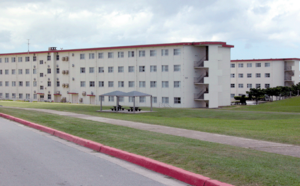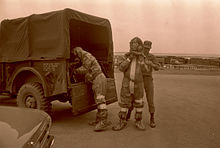Camp Kinser
| Camp Kinser | |
|---|---|
| Okinawa, Japan | |
 Barracks buildings on Camp Kinser. | |
| Coordinates | 26°15′09″N 127°41′51″E / 26.252528°N 127.697396°E |
| Type | Military base |
| Site information | |
| Controlled by | United States Marine Corps |
| Garrison information | |
| Past commanders | Colonel John E. Kasperski |
Camp Kinser is a United States Marine Corps logistics base in Okinawa, Japan.
Overview
Camp Kinser is a major logistics base for Marine Corps Forces on Okinawa. Its flagship command is the 3rd Marine Logistics Group. It sits adjacent to the East China Sea in the city of Urasoe, and just a few kilometers north of Naha.
Camp Kinser is the southernmost of nine Marine Corps bases on Okinawa, which make up Marine Corps Base Camp Smedley D. Butler. Another military installation, the Naha Port Facility which belongs to the U.S. Army is located south of Camp Kinser.
Camp Kinser is equipped with a DeCA Commissary, AAFES Shopette, and an AAFES PX, which houses a food court with eateries such as Subway, Pizza Hut, and Taco Bell. It sports a bowling alley, enlisted club, fitness center, and mess hall.
It was named for 21 year old Sergeant Elbert L. Kinser, who threw himself on a grenade to protect his fellow Marines at the Battle of Okinawa during World War II, and was posthumously awarded the Medal of Honor.
History
As of 2013, the U.S has indicated that it wants to return Camp Kinser also known as the Machinato or Makiminato Service Area to Japan by 2030.[1]
Environmental pollution
In 1993, the US government issued a classified report entitled "USFJ Talking Paper on Possible Toxic Contamination at Camp Kinser, Okinawa". Publicly available U.S. military documents have quoted excerpts suggesting extensive pollution with Vietnam era chemicals stored there, like insecticides including DDT and heavy metals, rodenticides, herbicides, inorganic and organic acids, alkalis, inorganic salts, organic solvents like vapor degreasers and ferric chloride, of which 12.5 tons were buried.[2][3]
Evidence of wildlife contamination are the 2013 finding of mongooses caught near the installation with high levels of polychlorinated biphenyls(PCBs) and the September 2015 report of habu snakes from the vicinity of Camp Kinser with elevated concentrations of PCBs and DDT. In 2009 six Japanese workers of a warehouse on the base had fallen ill of an unknown illness. A scholar from Okinawa International University has speculated that "the Pentagon wants to conceal the reality of contamination that would damage the political value of [Camp Kinser]'s return".[2]
Resident Commands

- 3rd Maintenance Battalion
- 3rd Marine Logistics Group
- 3rd Supply Battalion
- Combat Logistics Regiment 35
- Combat Logistics Regiment 37
References
- ^ Yomiuri Shimbun (31 March 2013). "U.S. to return Makiminato facility in Okinawa in 2020s". West Hawaii Times. Oahu Publications, Inc. Retrieved 20 September 2015.
- ^ a b Mitchell, Jon, "Pentagon blocks report on ‘toxic contamination’ at base outside Okinawa capital", Japan Times, 16 Sep 2015
- ^ Mitchell, Jon, "FOIA documents reveal hot spots, fish kills and toxic dumps on Okinawa military base", Japan Times, 29 September 2015
